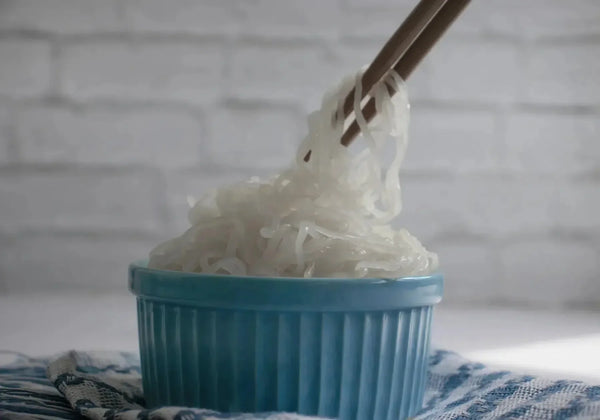
Jump to:
To many beginner explorers of Japanese cuisine, one of the foods with the least appetizing appearance may be the slab of a processed gray jelly-like substance called Konnyaku. This processed food, however, has been an integral part of the Japanese diet for centuries and is still used in a wide variety of dishes today.
In this article, we shall look at what Konnyaku is (we shall reserve the English term “Konjac” for when referring to its source plant), how it is made, and possible health benefits. We shall also look at different types of Konnyaku, the wide variety of products in which it can be found, including some non-food based items, popular dishes containing Konnyaku, and how to buy and store it.
What Is Konnyaku?
Konnyaku is a type of jelly made from the konjac, which is a type of yam, called the konjac (and sometimes as “devil’s tongue”) native to tropical and sub-tropical Asia. It was first introduced from China to Japan in the sixth century as a medicinal product. It has a gelatinous texture and virtually no flavor. For this reason, it is eaten with other tastier food rather than being eaten on its own and is a great low-cost way to improve the overall satiety of a dish. The majority of Konnyaku produced in Japan comes from Gunma Prefecture.
How Is Konnyaku Made?

Here, we shall introduce you to a method of how Konnyaku is made. Note that there may be various ways of making it, and this is just one example.
- Wash and peel the konjac potatoes (it is recommended that rubber gloves be worn to prevent irritation to the skin).
- Cut the washed and peeled potatoes into cubes 5-6 cm in size.
- Boil for 10-15 minutes. The potatoes should then be soft enough for a chopstick to pass through without resistance.
- Next is the grating stage. Take 1300 ml of lukewarm water, and leaving half a cup of the water, combine the remaining 1200 ml with the potatoes, and mix in several batches using a mixer.
- Put the contents of step 4 into a container (pot for stirring) and leave for about 1 to 2 hours. The lukewarm water left over from step 4 should then be added to the mixer to rinse off the potatoes from the mixer.
- Next, you need to make limewater. Combine 2 g of edible calcium hydroxide and 100 ml of water used for dissolving.
- Add the lime water in step 6 to the pot and stir quickly for 60-90 seconds.
- Put the solution from step 7 into a mold, smooth over with a spatula, and leave it to stand for one hour.
- Cut the hardened Konnyaku in half and boil in 80-90°C water for about 1 hour to harden.
- Boil again in a different pot of water to remove the starch, and you are all done!
Is Konnyaku Good For You?

Konnyaku is extremely healthy. It has no carbohydrates (making it great for people on a keto, or low-carb diet) and is high in glucomannan, a natural, water-soluble, dietary fiber. Like other soluble fibers, it aids weight loss by taking up space in your stomach, thus providing increased satiety, while being extremely low in calories. Its overall benefits for your stomach have led to Konnyaku having the nickname “I-no-hoki” literally “stomach broom”.
Glucomannan also feeds good bacteria in your intestine. These can transform into short-chain fatty acids like butyrate, which have been shown to protect against fat gain in some animals.
In addition to its impact on weight control, glucomannan has also been shown to protect against certain heart-disease risk factors by lowering cholesterol (which it does by reducing the cholesterol in your gut), as well as lowering triglycerides and fasting blood sugar. Konnyaku is also a good source of calcium and thus helps prevent bone-related diseases such as osteoporosis, as well as other vitamins and minerals.
Types Of Konnyaku
You may have noticed that Konnyaku comes in both white and gray colors. This depends on how it is made. As the method of making Konnyaku described earlier involves making it from raw potatoes, the skin will inevitably find its way into the Konnyaku, giving it a darker color. If it is made from refined konjac potato powder, however, it will be white. Sometimes seaweed powder is added to Konnyaku made from powder, which also gives it a darker color.
In addition to its color, Konnyaku is served in a wide variety of shapes and forms.
Board Konnyaku

This is the classic slab form that most readily comes to mind when people think of Konnyaku. Kneaded, paste-like Konnyaku is poured into a mold box, hardened, and cut into thick board-shaped pieces.
Ball Konnyaku

Here, the Konnyaku is rounded and boiled without using molds or the like. They include colorful varieties, and chili peppers, seaweed, and sesame seeds, etc. may be added. This is ideal for use with simmered dishes and O-den.
Shirataki (Thread Konnyaku)

This is made from Konnyaku formed into a thread, while passing it through thin holes while still in its glue-like state before it hardens. In the case of Shirataki, this is made from refined flour. As its flavor quickly blends with other flavors, it is ideal in dishes such as Sukiyaki as well as Aemono (sauce-dressed dishes).
Dessert-Style Konnyaku

Konnyaku-based desserts, such as Konnyaku Jelly have now become very common, with both Japanese and Western-style flavors. You can find a great range of flavors here. The popularity of the jelly has probably helped Konnyaku gain acceptance among children. Konnyaku pudding, ice cream, yogurt, and juice, are also available.
In addition to its primary use in food, Konnyaku is used in a wide range of beauty products. These include Konnyaku soap, beauty serum, cleansing lotion, and even a sponge for your face that is made of Konnyaku.
Popular Dishes Containing Konnyaku
Konnyaku is used in a number of popular Japanese dishes, and a few examples of these are given below.
Oden

Oden is a hearty dish particularly popular in the winter, which contains Konnyaku as one of its principal ingredients, in addition to Daikon, Kombu seaweed, eggs, and various fish paste-based delicacies. You can learn all about Oden here. And if you are interested in making it for yourself, check out this recipe for Kyoto-style Oden.
Sukiyaki

Although popular as a meat dish, Sukiyaki wouldn’t be the same without Shirataki, the noodle-like strands of Konnyaku. Although virtually tasteless on its own, it quickly absorbs the sweet, meaty flavors of the Sukiyaki sauce, and it is delicious in addition to being very filling. You can find a recipe for Kansai-style Sukiyaki here. If you are making it yourself, you might also like to try this Sukiyaki sauce from Kikkoman.
Dengaku Miso

Dengaku Miso is a dish in which a special sauce, using seasoned miso, which is spicy or sweet in varying degrees, depending on the region in which it is made and the miso used. As described earlier, Konnyaku itself is relatively tasteless, but it has a great texture that combines really well with the Dengaku miso sauce. Are you interested in making this sauce yourself? Check out this article that will tell you how.
Nabe

Another popular Japanese hearty winter dish is Nabe. The word Nabe itself simply means pot but in terms of Japanese cuisine, it refers to a hot pot containing a range of Japanese vegetables including Konnyaku. You can find an article on nabe, and a recipe for chanko nabe (traditional sumo food) on our website.
Choosing, Buying, Cooking, & Storing Konnyaku
You can purchase Konnyaku in ready-to-eat form as part of O-den in many Japanese convenient stores as well as outside some stores in Shotengai shopping streets. If you are planning to cook it yourself, it is also readily available in its multivariate forms in supermarkets and grocers.
When choosing Konnyaku, make sure that it is moderately elastic and not too soft. It is best to select ones with recent production dates.
Konnyaku can be cooked in either cold water or placed in boiling water. Both involve cooking the Konnyaku for approximately 2-3 minutes from the time the water boils, but it will be firmer and chewier when starting off the cooking process in cold water.
Konnyaku can be stored in the refrigerator for up to 60 days if left unopened. When buying Konnyaku, it will come with a special liquid. Make sure you don’t throw this away when opening it, however, as this high-pH water will allow you to store leftovers in the fridge for up to a month. If you happen to throw the liquid away by mistake, submerge the leftovers in water, and change the water every 2 or 3 days, you should be able to keep it for a week or so.
Konnyaku – The Cheap And Healthy Carb Substitute

As discussed in this article, there are a whole host of reasons why you should want to include Konnyaku as part of your diet. Virtually free of carbohydrates, Konnyaku is extremely filling and provides a lot of beneficial gut bacteria that will help you lose weight effortlessly. It also is a great source of vitamins and minerals and has been shown to reduce blood cholesterol.
Being low in price as well as very filling, it is also very effective at helping your housekeeping budget go further.
While not the most visibly appealing food and virtually tasteless, it has a chewy texture that many people grow to love and is able to absorb the flavors of the food it is cooked with to add something distinctive to a wide range of dishes.
What is your favorite way of eating Konnyaku? Let us know in the comments.


0 comments